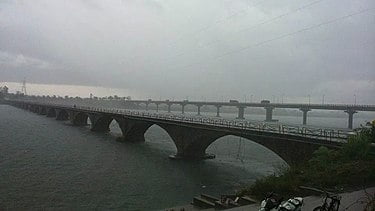Wainganga River

The Wainganga[a] is a river in India originating in the Mahadeo Hills in Mundara near the village Gopalganj in Seoni, Madhya Pradesh. It is a key tributary of the Godavari. The river flows south in a winding course through the states of Madhya Pradesh and Maharashtra, roughly 579 km (360 mi). After joining the Wardha River, the united stream, which is known as the Pranahita River, empties into the Godavari River at Kaleshwaram, Telangana.
The main stream of the Wainganga originates at Mahadev hills near Gopalganj, Seoni District,[1] on the southern slopes of the Satpura Range of Madhya Pradesh.
The river has developed extensive floodplains characterized by sweeping graceful meanders, low alluvial flats, and slip-off slopes. The river has high banks, which measure from 10 m (33 ft) to 15 m (49 ft) on either side. The northern part is surrounded by the Mahadeo hills and Satpura Range, with an average elevation of 625 m (2,051 ft) above sea level. The valley of the Wainganga River is forested and sparsely populated.
Balaghat and Bhandara are the major cities located on the bank of the Wainganga River, while Pauni, Desaiganj and Bramhapuri are smaller urban centers on the smallest of the river banks. The Wainganga River is the water lifeline of these cities and their primary source of water. The Government of Maharashtra is developing a protection wall for Bhandara to protect it from heavy flooding. This flood protection wall encircles Bhandara from east to south.
